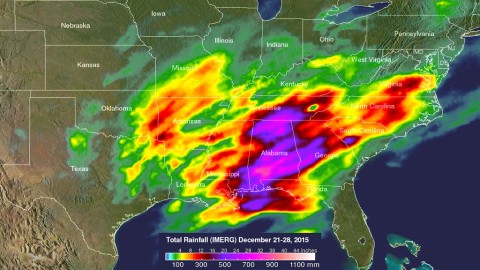Written by Hal Pierce / Rob Gutro
NASA’s Goddard Space Flight Center
 Greenbelt, MD – NASA’s Global Precipitation Measurement or GPM mission core satellite analyzed extreme weather that affected the U.S. over the course of five days. Heavy rainfall, flooding and tornado outbreaks affected areas of the United States from the Southwest through the Midwest from December 23rd to 27th, 2015.
Greenbelt, MD – NASA’s Global Precipitation Measurement or GPM mission core satellite analyzed extreme weather that affected the U.S. over the course of five days. Heavy rainfall, flooding and tornado outbreaks affected areas of the United States from the Southwest through the Midwest from December 23rd to 27th, 2015.
GPM is an international satellite mission between NASA and the Japan Aerospace Exploration Agency to provide next-generation observations of rain and snow worldwide every three hours.
[youtube]https://www.youtube.com/watch?v=PA4BS8AfKao[/youtube]
An analysis was made of the rainfall that occurred during the period from December 21st to 28th, 2015.This analysis used data generated by NASA’s Integrated Multi-satellitE Retrievals for GPM (IMERG). This analysis showed that during the past week the highest rainfall totals of almost 938 mm (36.8 inches) were measured by IMERG in the state of Alabama.
The GPM satellite passed above a line of tornadic thunderstorms moving through the Midwest on December 23rd, 2015 at 2232 UTC (5:32pm EST). GPM’s Microwave Imager (GMI) and Dual-Frequency Precipitation Radar (DPR) instruments had an excellent view of the violent weather occurring near the center of the satellite’s swath.
The supercell thunderstorm that moved from northern Mississippi into Tennessee generated two tornadoes. Fourteen deaths alone occurred with tornadoes that hit Benton, Mississippi on December 23rd, 2015.

GPM’s Radar (DPR Ku band) revealed the intensity of thunderstorms within this line of powerful storms. Many of those thunderstorms contained heavy showers that were returning 45 dBZ values or greater to the satellite (dBZ values (decibels of Z) represent the energy reflected back to the GPM satellite).
At NASA’s Goddard Space Flight Center in Greenbelt, MD the data was used to create a color enhanced 3-D view of the GPM radar’s slice through the line of storms.
Valleys across the Great Lakes and into New England.
The National Weather Service Weather Prediction Center (NWS/WPC) in College Park MD stated in the December 29th Short Range Forecast Discussion that residual flooding and/or the threat for flooding will persist from Oklahoma to Illinois.
NWS/WPC noted that several rivers across the Midwest were out of their banks on December 29th. Several locations along the Mississippi River from St. Louis down to the delta are anticipating major flooding, possibly even breaking record flood levels.
For updated forecast summaries from NWS/WPC, visit: www.wpc.ncep.noaa.gov
For more information about GPM, visit: www.nasa.gov/gpm



